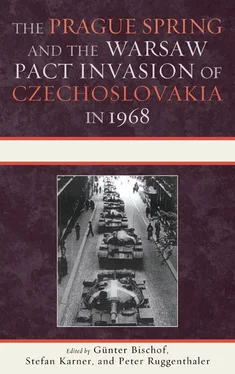If the PCI and PCF had some room to maneuver in international politics, it was also, in part, because of Moscow’s diminished interest in them. Soviet money now primarily went to Vietnam, Cuba, and the Arab countries; the two parties’ protest against repression in Czechoslovakia also deprived them of a lot of money, but not of their autonomy. In fact, financing from Moscow resumed in the early 1970s after a brief break. 45This renewed funding corresponded to the Soviets’ own redefinition of national security. The Western parties had ostensibly received more autonomy in the immediate aftermath of the 1956 events. A decade later, for the USSR, national security became more tightly dependent on ideological cohesion, anywhere , because of the increasing ideological permeability of its Eastern satellites. It is no accident that the PCI’s reform leader Amendola in 1971 first suggested the end of Soviet funding as a means to gain more autonomy in international politics. 46
Financial matters were not the only barometer of this increasing autonomy. The crisis of 1956, together with other events, had moved the main international focus to the emerging Third World. The year 1968 was a different story: it restored hopes among Western European Communists that revolution was possible in Europe and in the West, too.
THE MEANINGS OF EUROCOMMUNISM
It is now widely accepted that for both the PCF and (especially) the PCI, the decline of the Soviet model began in 1968, and both parties fully acknowledged that decline only by the mid-1970s. Until the mid-1970s, Italy’s Communists still analyzed world politics through Soviet lenses: the United States was in decline and power was shifting to the Soviet side. What the PCI seriously questioned from the late 1960s onward was the bipolarity implied in the détente process—or in the constant Soviet demonizing of the United States—as well as the internal practices of the Soviet camp.
After a meeting with a Soviet delegation in Budapest in November 1968, Berlinguer rejected his counterparts’ suggestion to intensify anti-NATO propaganda, as the PCF had done after its encounters with the CPSU of a few weeks earlier. Those pressures for tactical anti-Americanism, Berlinguer told Boris Ponomaryov, were unacceptable. 47It was the first time that the Italian Communists diverged from the Kremlin on anti-American propaganda.
By the mid-1970s, realizing that communism was no longer expanding, that Angola, and later, Afghanistan, were illusions, the Berlinguer leadership redefined the Soviet model from the geopolitical standpoint as well. In positioning itself as the middle path between social democracy and communism and in favor of European interdependence, Eurocommunism strove to deny both blocs. In January 1973 at a party meeting, Berlinguer defined a policy that would be “neither anti-Soviet nor anti-American.” 48In fact, with its anti-U.S. accents, its anticonsumerist ethic (all the campaigns for austerity and for a moral cleanup of Italian politics of the late 1970s and 1980s), it continued to favor a catastrophic vision of capitalist decline, thus reemphasizing its identity as the genuine harbinger of a reformed Eastern Bloc, as if the Prague Spring could be revived from the West. Faith in this capacity was essential; otherwise, Western communism would have been just another social democracy. 49
The paradox was that only under the Atlantic umbrella, Berlinguer thought by 1974, could Western communism be free to advance the true “socialism with a human face.” 50The PCI increasingly saw NATO as a vehicle of peace and détente: once détente was achieved, then emancipation from NATO would be possible.
Eurocommunism enjoyed a brief season of hope and moderate success. It is beyond the scope of this chapter to narrate its developments. It will suffice here to mention the milestones of this design orchestrated mainly from Rome. The theme was first addressed at a meeting between Marchais and Berlinguer in May of 1973, which also paved the way for the conference of the Western Communist parties held in Brussels the following year. Eurocommunism became the main banner of the ensuing meetings between Marchais and Berlinguer in November 1975, the PCF summit of a few days later with the Spanish Communists (PCE), renewed encounters between the French and Italian leaders in Paris in June of 1976, and, finally, the summit of the three leaders, including Santiago Carillo, in Madrid in March of 1977. The plenary conference of all European Communist parties, held in Berlin in June 1976, gave the three parties the chance to present their autonomous views within the Communist movement. Besides upholding their open cooperation with the Socialist and Social Democratic parties, the Western Communists abided by the declaration signed by Marchais and Berlinguer at their 1975 meeting, which supported the promotion of basic rights and freedom in Socialist societies. 51
In the end, Eurocommunism had a minimal impact on politics in the West; it did not significantly lift the U.S. veto on a Communist sharing of power. But it did have a subversive impact on the East, for it drew the attention of East Germans, Romanians, Poles, and Yugoslavs. The Soviet Union became hostile because of this “magnetism” and because of its own fear that Eurocommunism, with its increasing acceptance of NATO, would ultimately favor the militarization of Western Europe. 52Interestingly, from the other side, U.S. secretary of state Henry Kissinger also opposed the Eurocommunist idea because he thought that the PCI’s experimentalism would weaken Western resolve and work its subversive way through to dominate Italian politics. In this case, for the realist Kissinger, ideology and the struggle for the minds and hearts did matter. 53
What was most remarkable for both parties was that, although they ostensibly waged their main actions internationally, they both claimed their independence from Moscow first in their internal affairs, from as early as the mid-1960s. 54Embracing interdependence did not mean excluding a nationalist outlook. In fact, years after the Prague events, both parties continued to define the defense of national autonomy as the main achievement of the reform movement in Czechoslovakia. They shared an utter rejection of a restored Cominform under any disguise. 55
Again, traditions of nationalism and the nation-state, and even the nationalist belief that revolution had its roots in France, contributed to making the PCF more impervious than the PCI to any transnational option. The PCI was nationalist only intermittently and, like other Italian parties, looked at Europe as an instrument for the country’s emancipation from the Cold War. 56
But the emancipation from the blocs was also inherent in the PCF’s internal choice of siding with the establishment represented by François Mitterrand. Internal détente in France clashed with the external one, where the Soviet Union favored the ostensibly anti-Atlantic de Gaulle and his successors on the Right to a presumed pro-Atlanticist Mitterrand. It became an essential tactic for the Communists to have electable candidates. 57After a narrow loss by Mitterrand in the presidential elections of 1974, which was actually welcomed in the Left as an unexpected success, the PCF had to become the suitor in the relationship and part of the system. But when the common program with the French Socialists ( Parti Socialiste or PS) temporarily foundered in 1977, the Communists in most respects reverted to orthodoxy on matters of détente and European integration. 58
For the PCI, Eurocommunism also meant the beginning of the Historic Compromise with the Christian Democrats, an external support to the ruling party first proposed by Berlinguer in three famous articles in the party’s magazine Rinascita in the issues from October through December 1973. The main aim was that of eventually entering and transforming the government coalition. This was more of an anti-U.S., rather than an anti-Soviet, move. Following the coup in Chile against Salvador Allende, the Historic Compromise proposal was, in part, designed to prevent a similar scenario, invoking the common struggle against fascism, as in the postwar coalition of all democratic parties. 59
Читать дальше












